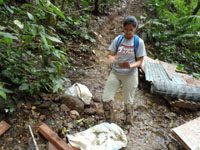July 16, 2012
Undergraduate participates in research program in Costa Rica
Submitted by Communications and Marketing

Waking up to howler monkeys greeting the morning, hiking past colorfully plumed toucans flying through the trees and looking out for poisonous vipers winding through the forest, Graciela Orozco, a junior biology and biological systems engeineering double major at Kansas State University, has been part of an immersive research experience in the cloud forest of Costa Rica. Graciela was one of 12 students selected to participate in a summer REU — Research Experiences for Undergraduates — that takes students to the Texas A&M University Soltis Center for Research and Education near the Monteverde Forest in central Costa Rica.
"The students will be investigating how the vegetation, moisture content and soil composition in a tropical cloud forest interact, from the scale of an individual leaf to the entire forest," said geography professor Chris Houser, principal investigator for the National Science Foundation-funded program.
Graciela and the other students of this summer’s REU class were prepared for the experience in a two-week introduction at Texas A&M. During this time, they met with faculty mentor to produce research proposals, prepared equipment for their experiments, and participated in seminars on research methods and field safety.
After arriving in Costa Rica, the students set up monitoring stations and began collecting field data. Each of their projects will contribute to the understanding of the water budget of a watershed in the forest. Outside of their own projects, the student will also receive lectures from participating faculty in hydrology, biogeography, climatology, geomorphology and ecohydrology to help them understand the dynamics of the cloud forest.
Houser says that scientists know that cloud-forest vegetation plays an important role in absorbing water from clouds, but the amount of moisture absorbed and its impact on the rest of the water cycle is less understood. The students will investigate some areas untouched by humans and other sites that have been logged or completely cleared, allowing them to investigate the role of vegetation.
"This 250-acre site allows the students to research the effects that changes in climate and in land have on the water cycle," Houser says.
The students’ research also provides a valuable service to the local Costa Rican communities. Since cloud forests exist near the top of Costa Rican watersheds, an understanding of the role of vegetation in the water cycle will help predict the availability of water downstream where most people live. It also will help identify how human activities have changed the cloud forest and if these activities have a negative affect on local development.
The students will be in Costa Rica until July 22, after which they will return to Texas A&M for two weeks to complete their analysis and present their findings at a dedicated research symposium. This is the second year of a three-year program bringing undergraduates to the Monteverde Forest. Charles William Soltis and his wife Wanda established the Soltis Center to provide international experiences for students while protecting the unique ecological setting and creating preservation awareness.
To follow the students through their research in the cloud forest, read Exploration of a Cloud Forest, the Costa Rica REU blog.
